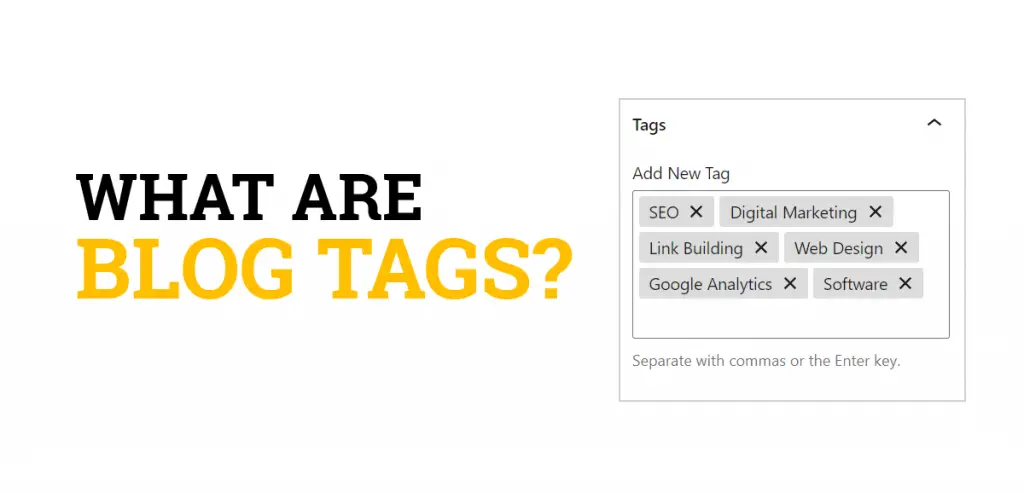A common question people have about blogging is: what are blog tags?
And when it comes to search engine optimization (SEO), digital marketers especially, want to know how do blog tags work for their website.
Are blog tags just another way to create keywords for your blog?
Are they more or less important than blog categories?
Well, regardless of the content management systems (CMS) you use, Hubspot, Wix, WordPress, etc. this all-encompassing guide can give you the answers you need.
Below, we’ll define what a blog tag is, give you some blog tag examples, and list the best practices you can follow for getting the most out of using tags on your website.

What Are Blog Tags?
Blog tags are words or phrases that describe a blog post. The purpose of a blog tag is to attach labels to your posts to link similar content together that addresses specific items you discuss in a particular blog post.
How Do Blog Tags Work?
Blog tags work by assigning a label to blog posts that link content together in the tag archive pages. A blog tag can work to improve the usability and experience of the blog readers so they can find related posts.
When you apply a tag to a blog post, it becomes listed in the archive page for that particular tag, along with any other post that’s been assigned that same tag.

Blog Tag Examples
Blog tag examples include cakes, pies, cookies, brownies, and bread for a blog category about baking. These examples of blog tags show how posts on a website can be grouped together based on the type of food being baked.
Another good example for blog tags for a website about SEO like this one would be:
- Category: Search Engine Optimization
- Tags: keywords research, link building, SEO tools, off-page optimization, local SEO
As you can see, the tags are sub-sections of the main category and many different posts can contain information about those tag topics, which makes them good to link together for the user to find and read.
Another blog tag example for a bodybuilding site would include:
- Category: Training
- Tags: arms, legs, back, abdominals
Best Practices for Blog Tags
1. Keep Blog Tags Short
The best blog tags are only 1-2 words, unless, of course, the phrase includes 3 words like “search engine optimization”.
Keep your tags short, concise, and meaningful so the user knows exactly what type of content they’ll get when clicking on the tag.
2. Limit 10 Tags Per Blog Post
According to WordPress, “You can add as many tags as you like to a post. However, the WordPress.com Reader will filter out posts using more than 15 tags and categories (combined) as an anti-spam measure.”
Although WordPress mentions 15 tags, most blogging and SEO experts agree that 10 tags per blog post is the best practice to follow so things don’t get out of hand.
Sticking to 10 tags per post is the best recommendation for WordPress sites from both a CMS and administrative perspective.
3. Don’t Create Redundant Tags
You should keep a good eye on your blog tags to avoid redundant or closely-related words.
For example, you wouldn’t want to have both an “SEO” tag and “Search Engine Optimization” tag. Neither would you want a “keyword” tag and “keywords” tag because their essential the same thing.
4. Don’t Be Too Narrow with Blog Tags
The purpose of blog tags is to link content with similar topics together. Therefore, you shouldn’t be too narrow with your tags in WordPress, HubSpot, Wix, or any other CMS platform.
If you follow the first tip above about keeping your tags between 1-2 words (3 at the max), then you can reduce your chances of making a mistake here.
You never want to create a tag that only applies to one or two posts on your blog. Otherwise, the use of that tag will be wasted.
5. Use Tags Consistently
As a follow-up to the last tip, you always want to consistently use your tags on your posts.
If you create a tag for a specific category on your blog, then you should continue to add that tag to other blog posts that cover similar information on that topic.
Following this best practice will allow your visitors to find more relevant information to satisfy their interests and search queries.
6. Delete Underused Tags
If a tag is not being used very much, then you should delete it.
Underused tags will not benefit the usability of your site. It’s best to delete those tags so the tag archive page is not accessible by the user.
7. Remove the Tag Archive Page from Google
Every tag creates a tag archive page. And this page can produce duplicate and thin content on your website.
Therefore, it’s best to remove the tag archive pages from Google’s index.
You can do this by adding a “noindex follow” directive in the website’s robots.txt file.
Here’s an example of the HTML code to put in the robots.txt file:
<meta name="robots" content="noindex, follow">This noindex follow tag tells Google and other search engines that the tag archive pages should not be indexed but the web crawler should still follow the links on the page and continue to crawl and index the site.
By using the noindex follow directive, the individual posts will still get the attention they deserve without competing against the tag pages or indexing duplicate content from the site.
Blog Tags vs Categories
Blog tags are meant to describe the specific details of your posts. You can think of tags as the words you’d find on an index page of a book. Tags let you categorize your content on a micro level and have no hierarchical structure.
Blog categories are meant for the general topics of your posts. You can think of categories as the words you’d find in the table of contents of a book, or in this case, your WordPress site. Categories let you categorize your content on a macro level and have a hierarchical structure, which means you can create sub-categories for improved navigation.
Do Blog Tags Help SEO?
As mentioned in my guide on this specific topic here: do tags help SEO, blog tags do not help SEO directly.
Instead, blog tags are best used to improve the structure and grouping of similar content on a website which is an important part of the user experience. And SEO experts agree that a good user experience is a ranking factor for Google, Yahoo, and Bing.
Therefore, tags can help search engine optimization for a blog in an indirect manner, but you shouldn’t depend on them for higher keyword rankings and website traffic.
How Do I Put Tags On My Blog?
In WordPress, you can put tags on your blog with the tag manager settings or through blog posts before you publish them.
Using the Tag Manager to Add Tags
- Go to “Posts”.
- Click on “Tags”.
- On the Tags page, you can add new tags, see what tags are being used, and filter to the specific posts that the tags are used on.
Using a Blog Post to Add Tags
- Go to “Posts”.
- Click on a blog post to open it in the WordPress Editor or click on “Add New” to create a new blog post.
- In the right sidebar menu, scroll down to “Tags”.
- Click on “Tags” to open the setting.
- Put a name in the “Add New Tag” field.
- Click the Enter key to create the new tag name.
Blog Tags Summary
I hope you enjoyed this guide that answers the question about what are blog tags.
As you discovered through the blog tag examples above, the basic concept around how do blog tags work is that they link together similar content on a website. However, tags are much more granular than blog categories.
Blog tags help improve the user experience and accessibility for the content on your website, which makes them a good feature to use on any WordPress, HubSpot, or Wix blog.

SEO Chatter is dedicated to teaching the fundamentals of search engine marketing to help marketers understand how to increase organic website traffic and improve search engine rankings.
